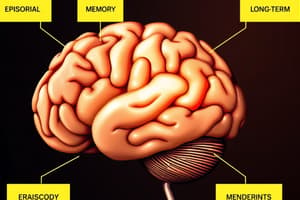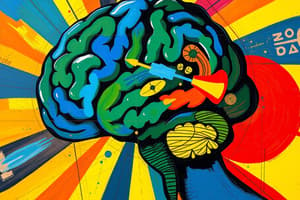Podcast
Questions and Answers
Which of the following best describes the 'problem' that long-term memory (LTM) aims to solve?
Which of the following best describes the 'problem' that long-term memory (LTM) aims to solve?
- To quickly process and discard irrelevant sensory input to prevent cognitive overload.
- To acquire information from experience, maintain it over time, and use it when relevant to guide behavior and plan future actions. (correct)
- To efficiently store every piece of information from experience without any loss.
- To create a perfect replica of past events, ensuring accurate recall of every detail.
Why is retentiveness considered important for progress?
Why is retentiveness considered important for progress?
- It ensures that individuals do not repeat past mistakes, regardless of context.
- It allows for absolute change and discarding of old information.
- It promotes a state of constant change, which is essential for innovation.
- It enables improvement and direction by building upon past experiences, preventing perpetual infancy. (correct)
Which of the following is NOT considered a core process involved in memory?
Which of the following is NOT considered a core process involved in memory?
- Suppression (correct)
- Encoding
- Storage
- Retrieval
The initial creation of memory traces in the brain from incoming information is referred to as:
The initial creation of memory traces in the brain from incoming information is referred to as:
What does the process of 'consolidation' in long-term memory refer to?
What does the process of 'consolidation' in long-term memory refer to?
Accessing and using stored information from memory traces is known as:
Accessing and using stored information from memory traces is known as:
What is the potential role of 'reconsolidation' in the context of memory?
What is the potential role of 'reconsolidation' in the context of memory?
Which type of long-term memory is associated with specific personal experiences from a particular time and place?
Which type of long-term memory is associated with specific personal experiences from a particular time and place?
World knowledge, object knowledge, and language knowledge are components of:
World knowledge, object knowledge, and language knowledge are components of:
Skills, whether motor or cognitive, are primarily associated with which type of memory?
Skills, whether motor or cognitive, are primarily associated with which type of memory?
What is the key difference between declarative and nondeclarative memory?
What is the key difference between declarative and nondeclarative memory?
The logic of 'dissociation' in memory research suggests that:
The logic of 'dissociation' in memory research suggests that:
What is a 'single dissociation' in the context of studying memory?
What is a 'single dissociation' in the context of studying memory?
What is the significance of a 'double dissociation' in neuropsychological studies of memory?
What is the significance of a 'double dissociation' in neuropsychological studies of memory?
In the context of memory studies, what does 'partial damage argument' refer to as an alternative explanation to dissociations?
In the context of memory studies, what does 'partial damage argument' refer to as an alternative explanation to dissociations?
What is the primary distinction between implicit and explicit memory?
What is the primary distinction between implicit and explicit memory?
Which of the following tasks would primarily rely on implicit memory?
Which of the following tasks would primarily rely on implicit memory?
What is 'perceptual identification' as used in the context of implicit memory tasks?
What is 'perceptual identification' as used in the context of implicit memory tasks?
Non-associative learning is defined by what characteristic?
Non-associative learning is defined by what characteristic?
Habituation, as a form of non-associative learning, involves:
Habituation, as a form of non-associative learning, involves:
Sensitization, as a form of non-associative learning, involves:
Sensitization, as a form of non-associative learning, involves:
What is pre-synaptic depression related to habituation learning?
What is pre-synaptic depression related to habituation learning?
What is the key process in classical conditioning?
What is the key process in classical conditioning?
In fear conditioning, what is the role of the amygdala?
In fear conditioning, what is the role of the amygdala?
The basal ganglia is MOST closely associated with the learning of what type of memory?
The basal ganglia is MOST closely associated with the learning of what type of memory?
Flashcards
What is Memory?
What is Memory?
The processes, types, systems and tasks involved in retaining information.
Problem of Long-Term Memory
Problem of Long-Term Memory
Acquiring information from experience, maintaining it, and using it to guide future actions.
LTM Processes
LTM Processes
Encoding, storage, retrieval and consolidation of memory traces.
Encoding
Encoding
Signup and view all the flashcards
Consolidation
Consolidation
Signup and view all the flashcards
Retrieval
Retrieval
Signup and view all the flashcards
Storage
Storage
Signup and view all the flashcards
Types of Long-Term Memory
Types of Long-Term Memory
Signup and view all the flashcards
Systems of Long-Term Memory
Systems of Long-Term Memory
Signup and view all the flashcards
Two major types of LTM
Two major types of LTM
Signup and view all the flashcards
Dissociation Logic
Dissociation Logic
Signup and view all the flashcards
Single Dissociation
Single Dissociation
Signup and view all the flashcards
Double Dissociation
Double Dissociation
Signup and view all the flashcards
Short-term Memory Task
Short-term Memory Task
Signup and view all the flashcards
Long-term Memory Task
Long-term Memory Task
Signup and view all the flashcards
Timescale of Short Term Memory
Timescale of Short Term Memory
Signup and view all the flashcards
Neural Basis of Long-Term Memory
Neural Basis of Long-Term Memory
Signup and view all the flashcards
Timescale of Long-Term Memory
Timescale of Long-Term Memory
Signup and view all the flashcards
Priming Effect
Priming Effect
Signup and view all the flashcards
Implicit long-term memory
Implicit long-term memory
Signup and view all the flashcards
Explicit long-term memory
Explicit long-term memory
Signup and view all the flashcards
Types of Implicit Memory
Types of Implicit Memory
Signup and view all the flashcards
Non-associative memory
Non-associative memory
Signup and view all the flashcards
Habituation
Habituation
Signup and view all the flashcards
Classical Conditioning
Classical Conditioning
Signup and view all the flashcards
Study Notes
- Topic is Long-Term Memory (Part 1)
What is Memory?
- Memory includes various processes, types, systems, and tasks
- Method for studying memory involves lesions and double dissociation
- Short-term and long-term memory are two types
- Memory can be implicit or explicit
Implicit Long-Term Memory
- Implicit memory includes non-associative learning, conditioning, skill learning, and priming
Explicit Long-Term Memory
- Explicit memory includes semantic and episodic memory, as well as consolidation and reconsolidation
Examples of Memory
- Examples include the taste of breakfast, what was eaten for breakfast, usual breakfast items, typical breakfast foods, the concept of breakfast, how to eat breakfast, and even a coffee stain
Long-Term Memory (LTM)
- Key problem: Acquiring information from experience, maintaining it, and using it to guide behavior and plan future actions
- Importance: Progress depends on retaining experiences; those who forget the past are doomed to repeat it
- Challenge: Determining what to remember from all experiences and how to retrieve it
Learning vs. Memory
- Learning is closely related to memory
- Memory involves processes like encoding, storage, and retrieval
- Types of memory include semantic, episodic, and procedural
- Memory systems: hippocampus, cortex, amygdala
- Memory tasks: free recall, stem completion, and motor sequence learning
- Physical changes occur in the nervous system with memory
- Memory is pervasive throughout the nervous system
LTM Processes
- Encoding: Initial creation of memory traces in the brain from incoming information
- Consolidation: Continued organization and stabilization of memory traces over time
- Storage: Retention of memory traces over time
- Retrieval: Accessing/using stored information from memory traces
- Reconsolidation: Possible reorganization and restabilization of memory traces after retrieval
LTM Types & Systems
- Memory is divided into long-term, sensory, short-term and working memory.
- Long-term memory includes declarative (explicit) and nondeclarative (implicit) memory
- Declarative memory encompasses events (episodic) and facts (semantic)
- Episodic memory involves specific personal experiences
- Semantic memory includes world knowledge
- Brain regions include the medial temporal lobe, middle diencephalon, and neocortex.
- Nondeclarative memory includes procedural memory, perceptual representation system, classical conditioning, and nonassociative learning
- Procedural memory involves skills (motor and cognitive)
- Regions: Basal ganglia and skeletal muscle
- Perceptual representation system involves perceptual priming
- Regions: Perceptual and association neocortex
- Classical conditioning involves conditioned responses between stimuli
- Regions: Cerebellum and Reflex pathways
- Nonassociative learning encompass habituation and sensitization,
- Regions: Reflex pathways
- Procedural memory involves skills (motor and cognitive)
Short-Term and Long-Term Memory
- Memory is categorized into short-term and long-term memory
Dissociating Short-Term and Long-Term Memory
- Goal is to determine if STM and LTM are separate systems using dissociation logic
- Dissociation: Performance differs across two tasks.
- Single Dissociation: If one function is impaired and another is spared
- A single dissociation does not necessarily demonstrate separable systems, distinct brain regions, or cognitive processes
- Double Dissociation: If two patterns are flipped
- Two patterns that are flipped and can be independently impaired is strong evidence that they rely on different brain mechanisms
Short-Term Memory (STM) Task
- Memory span is tested by hearing three words and immediately recalling them in the same order. "Time base offer" is an example
Long-Term Memory (LTM) Task
- Involves list learning, such as hearing ten words and immediately recalling them in any order, then repeating until all ten are recalled
Patient K.F
- Patient with damage to the left temporoparietal cortex
- Displays single dissociation
Danger: Single Dissociation Conclusion
- It's tempting to conclude that a short-term memory task depends on the temporoparietal junction, but long-term memory task doesn't
- Therefore, short-term and long-term memory are separate systems that depend on different brain regions and distinct cognitive processes-
Problem: Alternative Explanations for STM/LTM Dissociation
- Two alternative explanations exist: partial damage argument and compensation argument.
Partial Damage Argument
- Maybe there’s only one system for both STM and LTM.
- The STM task is harder than the LTM task.
- When partially damaged, the STM task suffers more than the LTM task.
Compensation Argument
- Maybe there is only one system for both short-term and long-term memory.
- STM task is harder than the LTM task.
- When this system is completely damaged, the brain can compensate for the LTM task but not the STM task
Patient H.M.
- Patient with damage to bilateral medial temporal lobes
Double Dissociation
- Double dissociation involves two different areas of damage resulting in two opposing single dissociations
- This pattern cannot be explained by task difficulty and strongly suggests that short-term and long-term memory are separable systems
Short-term Memory
- Timescale: seconds
- Capacity: extremely limited
- Neural basis: sustained activation of neurons
Long-term Memory
- Timescale: minutes, hours, days, years
- Capacity: massive
- Neural basis: number and strength of synapses
Implicit & Explicit Memory
- Memory can be classified into implicit and explicit forms
Dissociating Implicit & Explicit LTM
- Implicit memory task: Perceptual identification with a study and test phase
- Study phase: 24 words are presented for 2 seconds each
- Test phase: 24 old (studied) and 24 new words are flashed briefly to identify the word (priming effect)
- Explicit memory task: Word recognition with a study and test phase
- Study phase: 24 words are presented for 2 seconds each
- Test phase: 24 old (studied) and 24 new words are presented until response; participants respond "yes” or “no” if words are from study phase
Single Dissociation of Implicit & Explicit LTM
- Patient M.S. shows damage to the right occipital lobe
- Patient M.S. shows shows word recognition (explicit memory)
- Patient shows no priming effect (impairment in implicit memory)
Amnesia Patients
- Amnesia patients exhibit Korsakoff's syndrome & epilepsy.
- Amnesia patients display a larger than normal priming effect
- Amnesia patients display Impaired word recognition (impairment in explicit memory)
Double Dissociation of Implicit & Explicit LTM
- Involves two different areas of damage that results in two opposing single dissociations
- Cognitive and brain systems involved in perceptual identification (implicit memory) are distinct from those involved in word recognition (explicit memory)
Implicit Long-Term Memory
- Non-declarative
- Independent of conscious awareness
- Includes procedural memory, conditioning, nonassociative learning, or priming
- Timescale: minutes, hours, days, years
- Capacity: massive (e.g., ~1,000s of skilled motor sequences)
- Neural basis: number & strength of synapses
Explicit Long-Term Memory
- Declarative
- Available to conscious awareness
- Can be semantic or episodic
- Timescale: minutes, hours, days, years
- Capacity: massive (e.g., ~20,000 word families in adult vocabulary)
- Neural basis: number & strength of synapses
Implicit Memory: Non-Associative Memory
- Involves a change in the strength of a response to a single stimulus due to repeated exposure
Non-Associative Memory
- A stimulus does not change, but your response to it changes over time
Habituation
- Reduced response to a repeated stimulus
- Eg, stop noticing the ticking of a clock
Sensitization
- Increased response to a repeated stimulus
- Eg, rubbing your arm hurts more the longer you do it
Non-Associative Learning
- Involves sensory-motor reflex pathways
Non-Associative Memory
- First evidence of neural basis of non-associative memory came from studies in sea slug Aplysia
- Studied by Eric Kandel - 2000 Nobel Prize in Physiology or Medicine
Non-Associative Memory: Habituation
- Habituation: A decrease in response to a repeated stimulus
- Touching the siphon causes withdrawal of the gill
- Repeated siphon stimulation leads to less withdrawal
- Habituation leads to Pre-synaptic depression
- Same action potential
- Reduced neurotransmitter release
- Smaller EPSP
Non-Associative Memory: Sensitization
- Sensitization: An increased response to a repeated stimulus
- Touching siphon causes withdrawal of gill
- Shocking tail then touching siphon leads to more withdrawal
- Sensitization leads to Pre-synaptic facilitation
- Same action potential
- Increased neurotransmitter release
- Larger EPSP
Habituation & Sensitization: “Short-Term”
- Last for minutes
- Changes in amount of neurotransmitter released
- "Short-term” habituation/sensitization ≠ short-term memory
Habituation & Sensitization: “Long-Term”
- Last for hours, days, weeks
- Changes in number of synapses
Implicit Memory: Conditioning
- Memory type involves conditioning
Classical Conditioning
- Pavlov noticed that a dog learned to salivate in response to a bell that predicted food
- Unconditioned stimulus (US) = food and Unconditional response (UR) = salivation
- Neutral stimulus (NS) = bell (before pairing) leads to Conditioned stimulus (CS) = bell and Conditioned response (CR) = salivation
- Initially US (food) leads to UR (salivation). After pairing, CS (bell) leads to CR (salivation)
Fear Conditioning
- US = shock and UR = freezing and CS = tone which results in CR = freezing
Neural Circuit in Fear Conditioning
- CS and US converge in the lateral nucleus of the amygdala
Fear Conditioning: EPSP
- EPSP to tone increases in lateral nucleus of amygdala after repeated pairing with shock
Memory: Skill Learning
- Category of implicit memory
Skill Learning
- Motor adaptation
- Cerebellar loops
- Motor sequence learning
- Cortico-basal ganglia-thalamocortical loops
Skill Learning: Motor Adaptation
- Task: Throwing darts with prism glasses
- Eye-hand coordination
- Prism glasses shift visual field to side
- Control participants adapt to distortion
- Patients with cerebellar lesions fail to adapt
Motor Coordination & Cerebellum
- Cerebellum uses forward model to predict results of motor commands
- Uses differences between actual results and predicted results for online error correction, motor learning, and feedback control
Skill Learning: Motor Sequence Learning
- Serial reaction time (SRT) task: Each light turns on in a certain order; the job is to hit the appropriate buttons in that order
- Repetition improve completion and does not require conscious processing
- Depends on basal ganglia thalamo cortical loops
Skill Learning: Motor Sequence Learning
- Depends on basal ganglia & reinforcement learning by selecting actions expected to lead to maximum reward
- Prediction error = actual reward – predicted reward is used to update expectations
- Dopamine signal from substantia nigra pars compacta (SNc) represents prediction error
- Larger dopamine response means better than expected, smaller response means worse than expected
Basal Ganglia & Reinforcement Learning
- Unexpected rewards generate dopamine signals from the substantia nigra pars compacta (SNc)
- This excites the direct pathway (via D1 receptors) and inhibits the indirect pathway (via D2 receptors)
- This allows modification of behavior based on reward
Studying That Suits You
Use AI to generate personalized quizzes and flashcards to suit your learning preferences.




